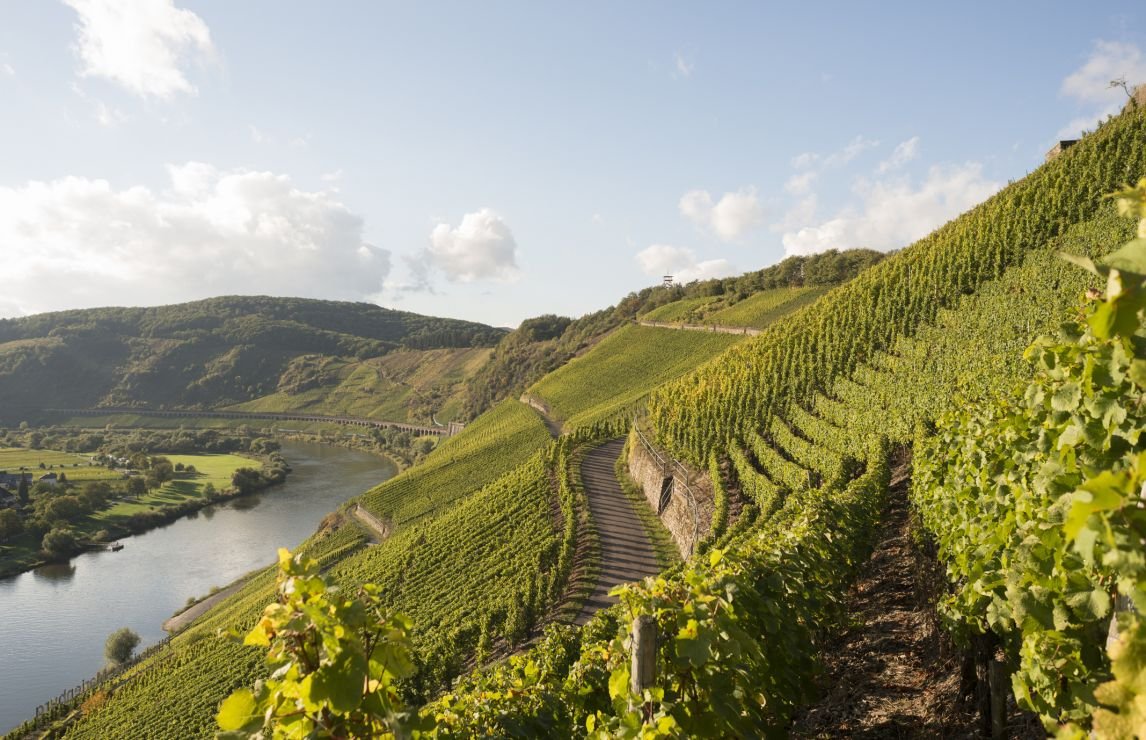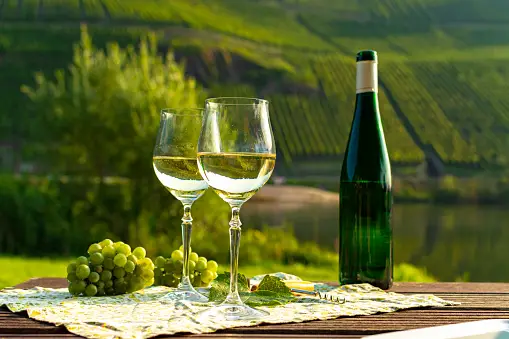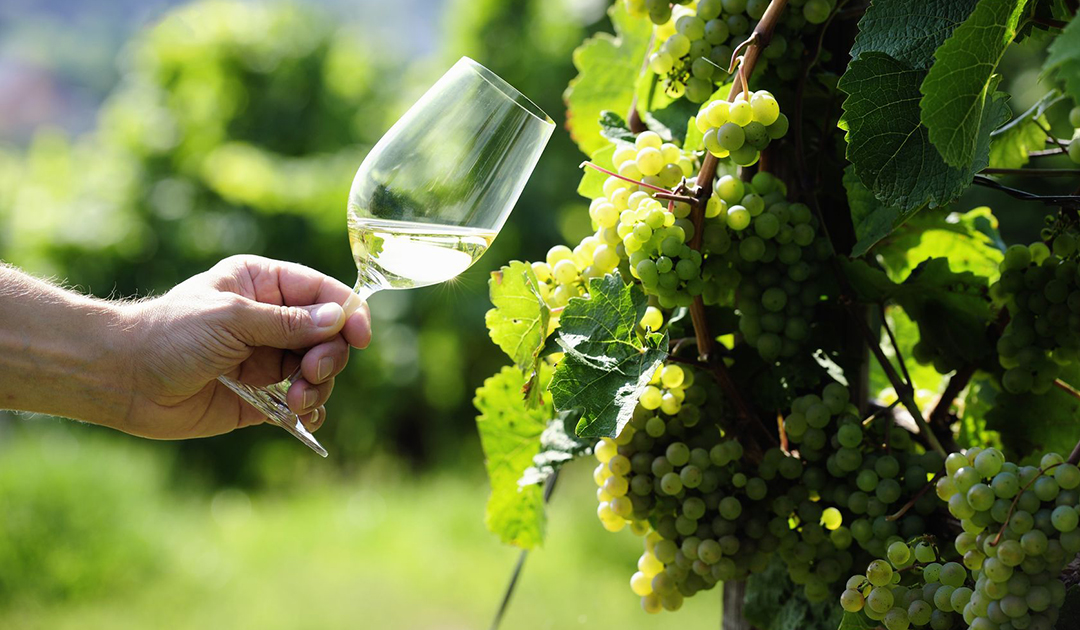‘Reece-ling’ must be the world’s most misunderstood, and mispronounced, grape variety. Loved by wine critics but a stranger to broad commercial appeal, Riesling is a light-skinned, aromatic grape of German origin which is also responsible for some of Germany’s greatest, and longest-lived, white wines. Riesling is made in a range of styles but generally produces crystalline, aromatic white wines with notes of citrus, wax and lanolin, with a light to medium body and plenty of fresh acidity. Its aromatic intensity, vibrant acidity, and ability to reflect terroir make it a fascinating subject for exploration.
Let’s delve into the world of Riesling, uncovering both its factual essence and its enduring allure.
Although widely associated with the wines of the Mosel and Alsace, Riesling is planted all over the world, and has established itself in the likes of Washington and Australia’s Clare and Eden Valley. It seems much of Riesling’s reputation in the latter half of the 20th Century was tarnished by the sea of chaptalized, low-quality wine exported from Germany in the 1970s and 80s. In truth, very little of that infamous wine was Riesling at all, but instead higher-yielding grapes such as Müller-Thurgau and Silvaner, but the reputation has nonetheless stuck.
Wine made from Riesling is quite unlike any other. It is generally light in alcohol, refreshingly high in fruity natural acidity (quite different from the harshness of added acid), has the ability to transmit the character of a place through its extract and unique aroma and, unlike Chardonnay, is capable of ageing for decades in bottle. Like top quality Chenin Blanc, but unlike Chardonnay, it performs best if fermented cool and bottled early without any malolactic fermentation or wood influence. Riesling is a star and, as you may discern, one of the greatest wine heroes.
Is so exceptionally good at expressing terroir, because it makes white wines that are so good at ageing. A fine Riesling almost demands time in bottle. They can be quite austere in youth (which may be why so many wine drinkers are wary of them). The prospect of a 50-year-old Riesling can be an appetising one while the number of white burgundies worth ageing past their 15th birthday is extremely small.
Relative to most other internationally known varieties, Riesling ripens quite early, so when planted in a hot climate its juice can be overripe and flabby long before any interesting flavours have developed in the grapes. In a cool climate such as that of the Mosel valley in northern Germany on the other hand, it is regarded as late ripening relative to the host of precocious varieties that were specially bred for these short summers.
That’s why, Riesling has also been stereotyped as just a sweet grape, used only to make sticky wines. But while botrytized Rieslings are among the finest sweet wines in the world, the majority of global Riesling wines are either dry or off-dry.
Young dry Rieslings tend to be very light in color, sometimes pushing into light gold hints, depending on the region and winemaking. Sweeter styles tend to be considerably more yellow/golden in hue.

What are the different styles of Riesling?
Riesling comes in a wide range of styles, from the dry, which makes a great aperitif, to the completely dried-out clusters of Trockenbeerenauslese, where sweetness becomes poetry.
Now, thanks to global warming, it is true that winemakers often produce purer and completely sugar-free wines, but we are only at the beginning of the Riesling revolution.
The classification is not immediately simple; the names are in German or French, so now let’s see in more detail how Rieslings are called based on their sweetness.
Let’s start with German wines. When a Riesling is “trocken,” it means that it is very dry, with no sugar residue.
Spätlese denotes a late harvest and a more substantial structure; they can be dry or have a hint of sugar content; they are sweet but not excessively so.
Riesling Auslese, intense wines that age and whose clusters may have been attacked by noble rot, opens the sweetest sweet wines.
Molds are one step up, and Beerenauslese Rieslings are made from clusters that have definitely been affected by Botrytis cinerea.
Let’s continue with the finest, talking about the Eiswein, the ice wines, whose clusters also freeze during the cold. The sugar concentration increases considerably.
And we end up with the sweetest and most amazing wine, the Trockenbeerenauslese, more unique than rare wines, whose clusters undergo extreme drying—practically dry raisins are squeezed—but the nectar that is born is fabulous, like the cost of these bottles.

What does Riesling taste like?
Riesling is a delicate wine that is aged in large barrels or exhausted barriques; you will never find a Riesling that tastes of vanilla and butter, and if you did, it would be a disaster; its delicate charm would be stifled. Refine in large barrels, which know how to sculpt flavor and acidity without adding any perfume. It’s not like Chardonnay, which can take on a thousand different personalities depending on the winemaker. Riesling has only one and does not tolerate even a trace of makeup; it is like a rose, graceful and sensitive.
However, it is a wine that has a great personality, is savory, has many flavors of stone and graphite, an intriguing acidity, and a lot of elegance. You will eventually find your favorite Riesling, from dry to sweet and mellow—true oenological pearls. However, keep in mind that structure and alcohol content are always very low, so expect fleshy and vertical wines rather than muscular ones.
That’s all; we are done, but we want to give you some advice. Be patient with Riesling. It is the most difficult wine to drink right away, and you need to train your taste buds to enjoy it.
Perhaps the first few times it is unsettling to taste an almost oily Riesling full of strange scents, but then little by little you will learn and unravel the skein.
In the meantime, you can start with South Tyrolean Rieslings, which are very mineral and clean but easily available, and then make comparisons with the German ones.
How should Riesling be served?
Riesling should be served chilled but not too cold, as this can mask its aromas and flavors. A temperature of around 45–50°F (7–10°C) is ideal for most Rieslings.
Riesling food pairings
Riesling is a special wine that goes well with dishes that are acidic, sweet and sour, spicy, or hot because of how well its sweetness and acidity go together. Extreme spiciness doesn’t go well with any wine, but the Riesling’s residual sugar makes up for a light spiciness very well.
As you savor a glass of Riesling, remember its journey—from German slopes to vineyards across continents. Let its vibrant acidity and aromatic allure transport you to the heart of terroir. Riesling, with its real-world complexities, remains an enduring favorite among wine connoisseurs.
Cheers to the timeless elegance of Riesling! 🥂

